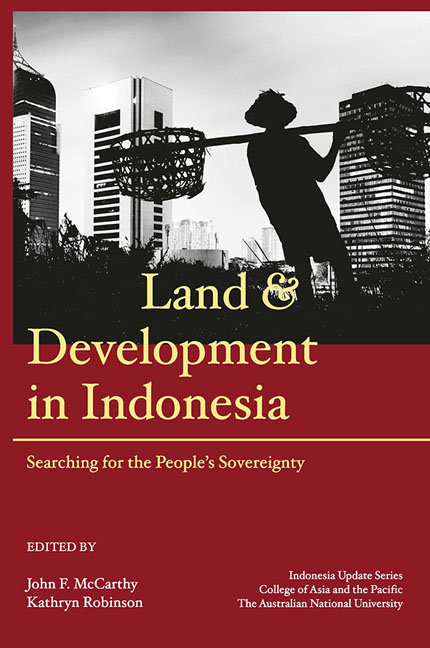Book contents
- Frontmatter
- Contents
- Tables
- Figures
- Contributors
- Acknowledgements
- Glossary
- Map
- 1 Land, economic development, social justice and environmental management in Indonesia: the search for the people's sovereignty
- PART 1 LAND USE AND LAND LAW: THE BIG PICTURE
- PART 2 ENVIRONMENTAL AND CUSTOMARY FRAMING OF LAND TENURE
- PART 3 URBAN AND INFRASTRUCTURE DEVELOPMENT
- PART 4 AGRICULTURE, LAND TENURE AND LIVELIHOODS
- 10 After 200 years, why is Indonesia's cadastral system still incomplete?
- 11 Agrarian transformations and land reform in Indonesia
- 12 Land tenure and agrarian structure in regions of small-scale food production
- PART 5 LARGE-SCALE LAND ACQUISITIONS AND SMALLHOLDER DEVELOPMENT
- Index
- Miscellaneous Endmatter
12 - Land tenure and agrarian structure in regions of small-scale food production
from PART 4 - AGRICULTURE, LAND TENURE AND LIVELIHOODS
Published online by Cambridge University Press: 29 July 2017
- Frontmatter
- Contents
- Tables
- Figures
- Contributors
- Acknowledgements
- Glossary
- Map
- 1 Land, economic development, social justice and environmental management in Indonesia: the search for the people's sovereignty
- PART 1 LAND USE AND LAND LAW: THE BIG PICTURE
- PART 2 ENVIRONMENTAL AND CUSTOMARY FRAMING OF LAND TENURE
- PART 3 URBAN AND INFRASTRUCTURE DEVELOPMENT
- PART 4 AGRICULTURE, LAND TENURE AND LIVELIHOODS
- 10 After 200 years, why is Indonesia's cadastral system still incomplete?
- 11 Agrarian transformations and land reform in Indonesia
- 12 Land tenure and agrarian structure in regions of small-scale food production
- PART 5 LARGE-SCALE LAND ACQUISITIONS AND SMALLHOLDER DEVELOPMENT
- Index
- Miscellaneous Endmatter
Summary
Indonesia's staple food-grain agriculture is dominated by ‘smallholder’ farmers, but these smallholder communities are not homogeneous, egalitarian or static. Both macro data (such as the six decennial agricultural censuses since 1963) and various micro studies reveal considerable regional variation in patterns of land ownership and control; micro studies also show the universality of agrarian class differentiation (to varying degrees) in all Indonesian ‘smallholder’ farming communities between large landowners, middle owner–operator farmers, tenant farmers, and near-landless or landless farm workers. Both macro data and the available micro-level village studies also document the dynamics of change in patterns of land control and rural differentiation over time (White and Wiradi 1989; Bachriadi and Wiradi 2011).
Inequalities in land control are problematic for many reasons. Besides threatening the sustainability of domestic food production, they have negative effects on the distribution of employment opportunities and incomes in the agricultural sector and the rural economy generally. In the past, Asian rice-producing countries such as Japan, South Korea and Taiwan successfully implemented land and tenancy reforms that put an end to landlordism, imposed rigid maximum holding limits and turned tenant farmers into owners. The experience of these countries shows that such reforms, when well implemented, result in significant improvements in productivity, smallholder farmer welfare and rural income distribution, and lead to positive interactions between the farm and rural non-farm sectors (Saith 1986; Lipton 2009).
Law 5/1960 on Basic Agrarian Principles (the Basic Agrarian Law) established the principle that land has a social function, meaning that it must be treated as a means to promote social justice, not to further individual interests that promote concentration and the exploitation of the weak by the strong. The Basic Agrarian Law and Law 2/1960 on Share Tenancy provide for maximum limits on land ownership (with the maximum varying according to local conditions), regulation of the sharing of costs and benefits between share tenants and landowners, and the prohibition of absentee landlordism. But these provisions were never implemented; the land reform courts and committees were dissolved in 1970, soon after Suharto took power. His New Order regime prioritised the implementation of Green Revolution programs to increase rice production, without significant efforts to stem the process of differentiation in land control that normally accompanies agricultural commoditisation; rice imports were eliminated in normal years, and rural poverty incidence declined, but inequality increased.
- Type
- Chapter
- Information
- Land and Development in IndonesiaSearching for the People's Sovereignty, pp. 265 - 294Publisher: ISEAS–Yusof Ishak InstitutePrint publication year: 2016



